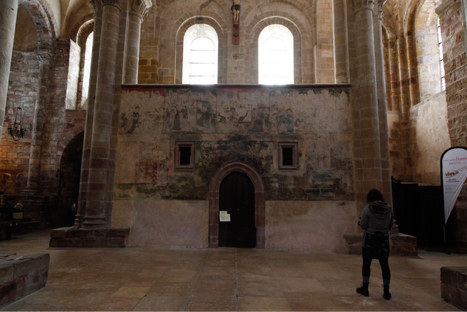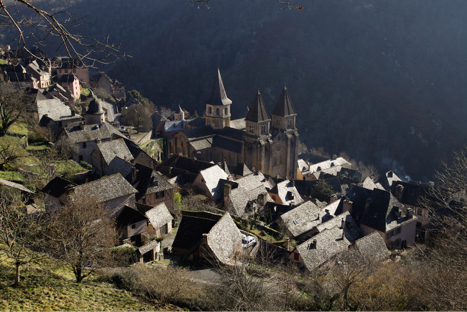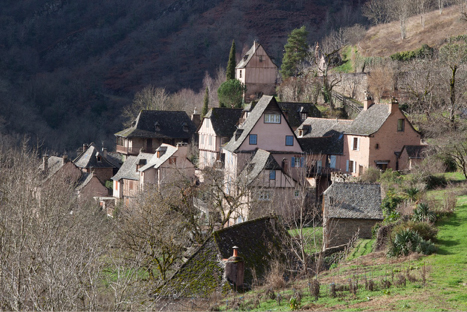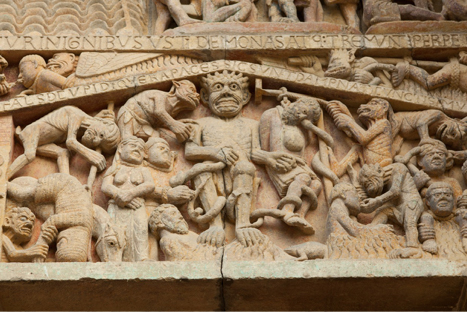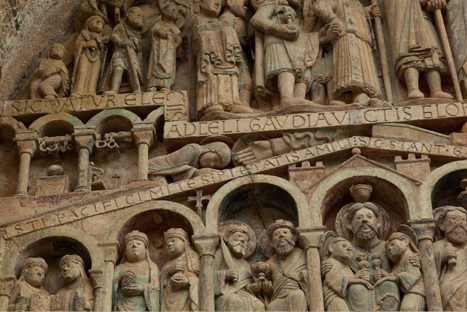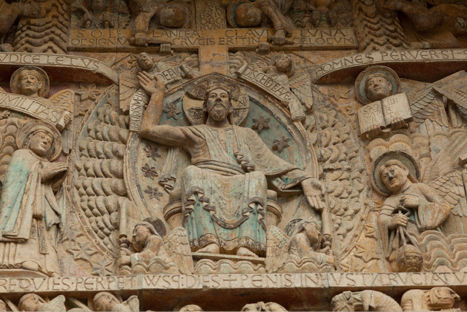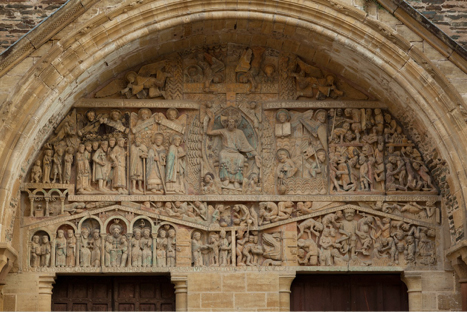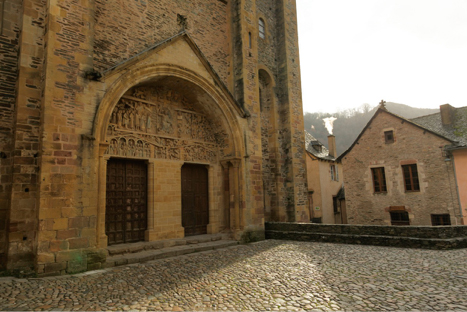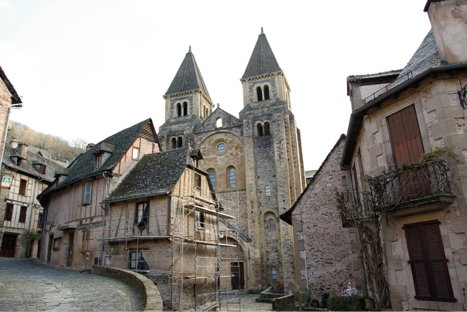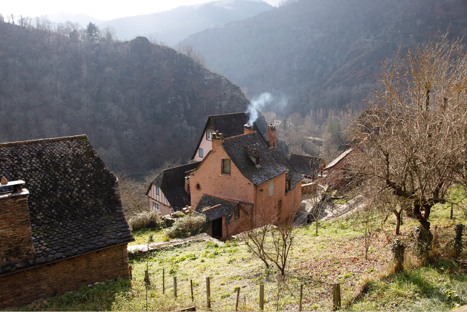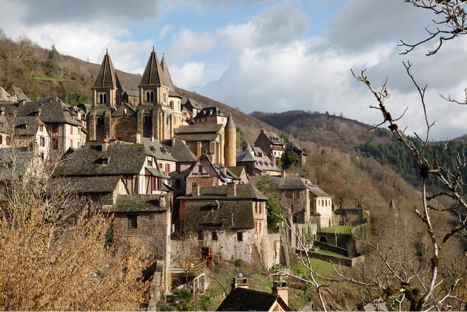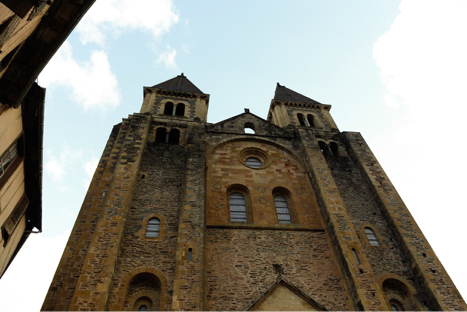Kristen Racaniello
Grant awarded Fall 2015
I was overjoyed to receive the Kossak Travel Grant which allowed me to further research that I had begun on the materiality of pigment in medieval Europe. This Grant led to the development of my thesis research on the culture surrounding the shrine, cult statues, and votive objects in medieval France.
With the Kossak Travel Grant I visited the Abbey church of Sainte Foy in Conques, France. The tympanum at Conques is one of the most well preserved examples of painted architectural relief still visible from the Middle Ages. It depicts the Last Judgement, a popular subject for medieval artists.
The Romanesque Last Judgement tympanum at the church of Sainte Foy was transformed by paint. The limestone of this relief was a vehicle for color, and that was necessary because it suggested specific meanings to the medieval viewer that were attributed to each color, and because the very nature of pigments as a material communicated an unearthly purity and humility. The materiality of an object was crucial to the Medieval viewer’s understanding of a work of art.
Pigments were an alien form of color in the medieval period. These were not encountered naturally in large quantities, but harvested and processed in order to become refined pigments. They represent the medieval audience’s conception of the pure colors of heaven in part because they have been distilled into pure materials. Dominic Janes has observed that for medieval scholars and the early Christian Fathers “‘the purest dyes’ are the most humble and the most holy, who know that they are only virtuous through the action of Grace.” The purity of materials employed for devotional art was of great concern to medieval audiences.
While in Conques, I was struck by the way the natural pigmentation of the landscape effects one’s perception of the colors on the church. The greens and blues of the remaining pigments stood out vivid and alien in the pink landscape. The dirt of the area is an orange-tinged pink, and this reflects in the surrounding buildings, which have been quarried from a local source and subsequently carry a color that is particular to this locale.
The Last Judgement scene which adorns the Abbey church at Conques is significant not only for the materiality of the pigment, but also because it speaks to the use of painting as a tool for narration. Gregory the Great, who reigned as Pope from 590-604CE, wrote that “illiterate men can contemplate in the lines of a picture what they cannot learn by means of the written word.” Religious images took form as the ‘bible of the poor’ and were used as tools to convey biblical scenes. In the Last Judgement tympanum at Conques there are a few fascinating additions atypical of Last Judgement iconography.
The most striking deviation in iconography is the addition of a depiction of Ste. Foy to the tympanum. In the Liber Miraculorum Sancte Fidis, the compilation of her miracles begun by Bernard of Angers, Sainte Foy is portrayed as a protective but mischievous saint. Her miracles frequently revolved around the freeing of prisoners, as many saints whose cults grew popular in the 11th century did due to the tumultuous state of the ruling nobility and the persistent warfare over land and religion in France. In the tympanum depiction Sainte Foy is shown kneeling and praying before the hand of God while behind her is a throne, an altar, and rounded arches from which dangle the shackles of prisoners. These shackles were left as votives, that is, objects which are given as “thank” offerings to a saint who has performed a miracle. The chain of communication depicted here is clear; Ste. Foy has the power to speak with God and intercede on the behalf of the faithful who have left these objects for her. The space behind her is a depiction of space inside the church and of objects that may have been left at her shrine as votive offerings.
Walking through the doors of the Abbey church of Sainte Foy and under the tympanum also forced me to think about how we interact with space mentally. The depiction of the altar on the exterior of the church, with votive offerings and the imaginary chain of communication, set up viewers to expect certain events to occur inside the space of the church. I could draw parallels between the altar in the center of the church and the altar depicted on the tympanum. Although the cult statue of Sainte Foy no longer resides on an altar within the church space, I could imagine what it would have been like to walk through the doors of the church, with the tympanum imagery as preparation for what lay inside.
While in France, I also visited Paris, where I traveled to the Musee De Cluny, the Louvre, the cite de l’architecture et du patrimoine, and the museum of Decorative Arts. This was an invaluable part of my experience as I was able to search out objects related to the tympanum at Conques that rarely travel outside of France.
I would like to thank Hunter College and the Kossak Fund for making my travel and research possible through this scholarship. This experience was essential to expanding my understanding of the artistic and geographic context in which the cult of Sainte Foy functioned. I gained an invaluable insight into the collective atmosphere of color and pigmentation that would have surrounded medieval viewers in Conques and was impressed by the vibrancy and unusual quality of the tympanum pigments within a primarily monotone landscape.
Although it is possible to view medieval objects such as reliquaries, cult statues, or illuminated manuscripts in the United States, the public works of the middle ages, that is, architecture and its pigmented surfaces, are simply not available to view in person in the Americas. It is inadequate to view these monuments through screens or even through printed photographs because scale–– especially the contextual scale of surrounding structures–– is essential to understanding their past and current functions.
My research into this area, and my subsequent thesis–– which deals with issues stemming from the necessity of context, performance, and materiality in understanding the Romanesque shrine–– would not have been possible without your support.
For more information on silver see: Herbert L. Kessler, “The Eloquence of Silver: More on the Allegorization of Matter,” in L’ allégorie dans l’art du Moyen Âge: formes et fonctions; héritages, créations, mutations, ed. Christian Heck Turnhout: Brepols, (2011), 49–64.
Dominic Janes, God and Gold in Late Antiquity. Cambridge University Press, (1998), 88.
